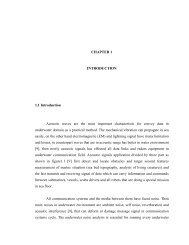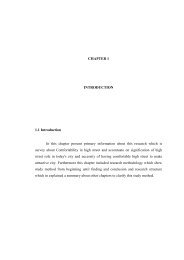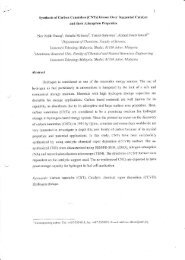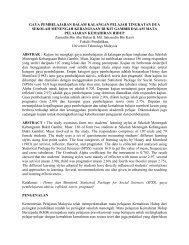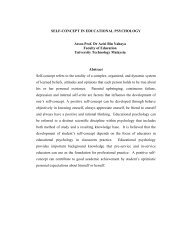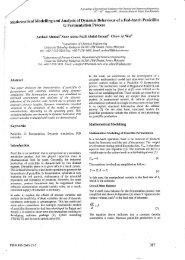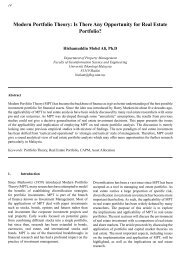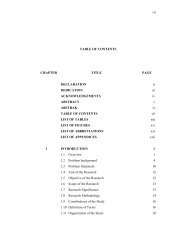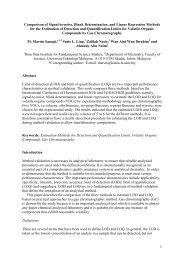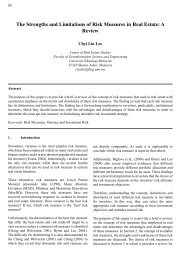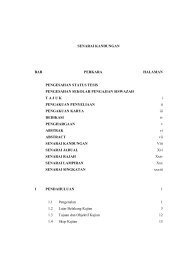Rational approach to the selection of conditions for diastereomeric ...
Rational approach to the selection of conditions for diastereomeric ...
Rational approach to the selection of conditions for diastereomeric ...
You also want an ePaper? Increase the reach of your titles
YUMPU automatically turns print PDFs into web optimized ePapers that Google loves.
F. C. Ferreira et al. / Tetrahedron: Asymmetry 17 (2006) 1337–1348 1341<br />
salts are <strong>for</strong>med (Fig. 2a), and due <strong>to</strong> <strong>the</strong> low solubility <strong>of</strong><br />
<strong>the</strong>se salts (Ks AR2 = 14 mM and Ks AS2 = 11 mM), both<br />
precipitate, yielding a solid with negligible ee (Fig. 2d).<br />
PEA resolution was per<strong>for</strong>med in isopropanol–water<br />
50:50 wt % at 22 °C and with an amine concentration <strong>of</strong><br />
176 mM. The maximum experimental ee observed was<br />
55.2% at C = 0.35, whereas <strong>the</strong> model predicts an ee <strong>of</strong><br />
100%. The <strong>the</strong>oretical value is consistent with a high solubility<br />
<strong>for</strong> <strong>the</strong> (R)-PEA neutral salt (Ks AR2 = 387.3 mM)<br />
and a lower solubility <strong>for</strong> <strong>the</strong> (S)-PEA salt (Ks AS2 =<br />
28.3 mM). The divergence <strong>of</strong> <strong>the</strong>oretical and experimental<br />
values might be due <strong>to</strong> <strong>the</strong> <strong>for</strong>mation <strong>of</strong> <strong>the</strong> mixed enantiomer<br />
neutral salt, which was not accounted <strong>for</strong> in <strong>the</strong> model.<br />
At C > 1, both (R)-PEA and (S)-PEA acid salts are <strong>for</strong>med<br />
at concentrations significantly higher than <strong>the</strong>ir solubility<br />
limits (Ks AR = 2.8 mM and Ks AS = 4.7 mM), and<br />
<strong>the</strong>re<strong>for</strong>e, both salts precipitate, yielding a solid with negligible<br />
ee.<br />
In <strong>the</strong> case <strong>of</strong> PEA, it is also interesting <strong>to</strong> note that <strong>the</strong>oretical<br />
and experimental results show a slight negative ee<br />
between 0.5 < C < 1.0. This result is <strong>the</strong> consequence <strong>of</strong><br />
an inversion in <strong>the</strong> order <strong>of</strong> solubility <strong>for</strong> <strong>the</strong> (S)- and<br />
(R)-salts, when both neutral and acidic PEA salts are<br />
<strong>for</strong>med. That is, in this model system <strong>the</strong> more soluble salt<br />
<strong>of</strong> <strong>the</strong> neutral salts is, by far, <strong>the</strong> neutral (R)-salt, however<br />
<strong>the</strong> opposite situation occurs <strong>for</strong> <strong>the</strong> acidic salts, in which<br />
<strong>the</strong> (S)-salt is more soluble than <strong>the</strong> (R)-salt. For this region<br />
in C, <strong>the</strong> four salts are <strong>for</strong>med (Fig. 2a) and <strong>the</strong> inversion<br />
<strong>of</strong> <strong>the</strong> ee observed is a consequence <strong>of</strong> <strong>the</strong> balance<br />
between <strong>the</strong> <strong>for</strong>mation and different solubilities <strong>of</strong> <strong>the</strong>se<br />
four species. Moreover, <strong>for</strong> <strong>the</strong> same range <strong>of</strong> C values,<br />
<strong>the</strong> calculated and experimental Y follows <strong>the</strong> same trend,<br />
which once again is ruled by <strong>the</strong> diastereomer salt<br />
solubility.<br />
2.2. <strong>Rational</strong> design <strong>of</strong> resolutions<br />
The above comparison between model calculations and<br />
experimental data shows that <strong>the</strong> model predictions are<br />
reasonably accurate <strong>for</strong> <strong>the</strong> two model systems presented.<br />
This suggests that this model <strong>approach</strong> can be used <strong>for</strong><br />
design <strong>of</strong> o<strong>the</strong>r resolutions.<br />
Notice that a transition between high and low ee was found<br />
<strong>for</strong> both neutral (PEA, Fig. 3a) and acidic salt (PPI2, Fig. 3c)<br />
based resolutions. Examination <strong>of</strong> species pr<strong>of</strong>iles (Fig. 2a)<br />
shows that <strong>the</strong> highest variety <strong>of</strong> <strong>diastereomeric</strong> salts is<br />
found <strong>for</strong> 0.5 < C < 1.5. For this range <strong>of</strong> C values, all <strong>the</strong><br />
<strong>diastereomeric</strong> salt solubility limits have <strong>to</strong> be accounted<br />
<strong>for</strong>, increasing <strong>the</strong> complexity <strong>of</strong> <strong>the</strong> resolutions per<strong>for</strong>med<br />
under such <strong>conditions</strong> and seldom yielding highly enantiopure<br />
products. There<strong>for</strong>e, more enantiopure products are<br />
obtained at C < 0.5 or C > 1.5. This observation contradicts<br />
<strong>the</strong> usual practice, reported in <strong>the</strong> literature, <strong>of</strong> screening resolution<br />
<strong>conditions</strong> at one mole equivalent (C = 1.0).<br />
A second important argument <strong>to</strong> be made is that, depending<br />
on <strong>the</strong> solubility limits, more efficient resolutions can be<br />
achieved when <strong>the</strong>y are based on <strong>the</strong> <strong>for</strong>mation <strong>of</strong> acidic<br />
salts, ra<strong>the</strong>r than neutral, and thus C > 1.5 should be preferentially<br />
employed. This suggestion is based on two different<br />
observations; <strong>the</strong> first is related <strong>to</strong> <strong>the</strong> potential<br />
<strong>for</strong>mation <strong>of</strong> mixed enantiomer neutral salts, resulting in<br />
poor ee. The second point is related <strong>to</strong> Y (Fig. 3b and d);<br />
as a consequence <strong>of</strong> a low usage <strong>of</strong> resolving agent, more<br />
free amine is left in solution (Fig. 2b), leading <strong>to</strong> a lower<br />
Y in a neutral salt (PEA) based resolution than in an acidic<br />
salt based resolutions (PPI2). Once again, this suggestion<br />
differs from <strong>the</strong> strategy suggested in <strong>the</strong> literature, where<br />
<strong>the</strong> majority reported work employs C 6 1, usually<br />
claiming that this procedure leads <strong>to</strong> savings on resolving<br />
agent. We advocate that molar ratios <strong>of</strong> greater than<br />
1.5 be employed, and suggest that <strong>the</strong> increased use <strong>of</strong><br />
resolving agents is countered by development <strong>of</strong> facile<br />
techniques <strong>for</strong> recovery and re-use resolving agents within<br />
a process.<br />
There<strong>for</strong>e, <strong>the</strong> proposed <strong>approach</strong> <strong>for</strong> designing <strong>diastereomeric</strong><br />
resolutions consists <strong>of</strong> focusing on <strong>the</strong> measurement<br />
<strong>of</strong> <strong>the</strong> solubility <strong>for</strong> <strong>the</strong> four enantiopure diastereomer salts<br />
in different solvent systems and at different temperatures,<br />
as follows:<br />
1. Obtain <strong>the</strong> pure enantiomers through alternative resolution<br />
techniques or with consecutive <strong>diastereomeric</strong><br />
resolutions.<br />
2. Select potential resolution solvent systems. Methanol,<br />
ethanol, isopropanol, ethylacetate and ace<strong>to</strong>ne and <strong>the</strong>ir<br />
respective water mixtures are <strong>the</strong> most commonly<br />
employed and <strong>the</strong>re<strong>for</strong>e <strong>the</strong> suggested candidates <strong>for</strong> solvent<br />
systems.<br />
3. Estimate <strong>the</strong> solubilities <strong>of</strong> <strong>the</strong> four pure <strong>diastereomeric</strong><br />
salts (Ks AS , Ks AR , Ks AR2 and Ks AR2 ) in different<br />
solvents and at different temperatures. For example,<br />
<strong>the</strong> solubility curves <strong>for</strong> <strong>the</strong> salts in different solvent systems<br />
can be obtained by adding several concentrations<br />
<strong>of</strong> pure enantiomer and resolving agent at C < 0.2 and<br />
C > 1.5 (respectively, <strong>for</strong> neutral and acidic salt<br />
<strong>for</strong>mation).<br />
4. Temperature pr<strong>of</strong>iles over time, consist <strong>of</strong> an initially<br />
higher temperature (sometimes at solvent boiling temperature)<br />
with <strong>the</strong> aim <strong>of</strong> dissolving all <strong>the</strong> material in<br />
solution, followed by a decrease in temperature, until<br />
precipitation is observed and finally, a plateau at a temperature<br />
low enough <strong>to</strong> ensure that equilibrium has been<br />
achieved.<br />
5. Compare <strong>the</strong> solubilities between <strong>the</strong> two acidic salts and<br />
<strong>the</strong> two neutral salts in <strong>the</strong> different solvent systems and<br />
establish which resolution solvent system and type <strong>of</strong><br />
salt, neutral or acidic, provides <strong>the</strong> larger difference in<br />
solubilities between <strong>the</strong> (R)- and (S)-<strong>diastereomeric</strong><br />
salts.<br />
6. Select <strong>the</strong> concentration <strong>of</strong> <strong>the</strong> racemic base (i.e., racemic<br />
base in resolution solvent) <strong>to</strong> be employed in order <strong>to</strong><br />
ensure that a crystalline solid with 100% ee is obtained.<br />
This concentration should be such that <strong>the</strong> more soluble<br />
salt remains entirely dissolved in <strong>the</strong> mo<strong>the</strong>r liquor, but<br />
<strong>the</strong> less soluble salt is present in quantities high enough<br />
<strong>to</strong> saturate <strong>the</strong> liquid solution and yield a solid product.<br />
In o<strong>the</strong>r words <strong>for</strong> a resolution based on acidic salt<br />
<strong>for</strong>mation, <strong>the</strong> concentration <strong>of</strong> racemic amine fed<br />
should be lower than twice <strong>the</strong> more soluble acidic salt



